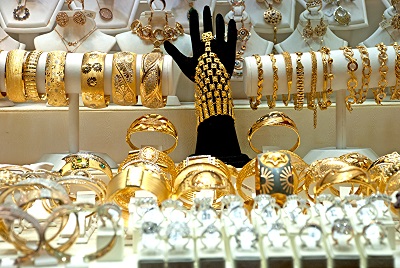Gold investments: how liquid is the crisis metal?
Gold facts & figures Arnulf Hinkel, financial journalist – 31.03.2021
Gold is far more than just a safe haven for investors or raw material for jewellery. Without gold, modern medicine and smart technologies would hardly be conceivable.
 Ever since its discovery in the early Copper Age around 5200 BC, gold has enjoyed great popularity. Due to its special properties, it has always been a sought-after material, and with its lasting brilliance and rarity, it is used both to demonstrate and reliably store wealth. It was therefore introduced as a globally recognised currency around 560 BC and remains an official means of payment in many countries to date.
Ever since its discovery in the early Copper Age around 5200 BC, gold has enjoyed great popularity. Due to its special properties, it has always been a sought-after material, and with its lasting brilliance and rarity, it is used both to demonstrate and reliably store wealth. It was therefore introduced as a globally recognised currency around 560 BC and remains an official means of payment in many countries to date.
In times of crisis, gold is valued as a safe haven and inflation protection, most recently evident last year when Covid-19 caused a global pandemic. Gold coins and bars in an amount of 896 tonnes were produced in 2020. Another 877 tonnes went into collateralising gold funds and physically backed gold ETCs, and central banks also expanded their gold holdings by 273 tonnes in 2020. Total demand for gold in 2020 was, however, 3,760 tonnes. So what happened to the remaining 1,714 tonnes? The lion’s share, at 1,412 tonnes, went into the production of high-quality jewellery and luxury accessories. The remaining 302 tonnes were used for various purposes in the industrial tech, research and medical sectors.
Gold jewellery: unrivalled accessory for the past 7,000 years
 Aside from its unique brilliance, the precious metal is unlike most other materials in that it does not corrode, i.e. it does not react to oxygen and therefore never changes in appearance. Further advantages of gold are its low melting point and the relatively easy combinability with other metals such as silver, copper, platinum or nickel to form so-called gold alloys, which predestine gold for use in jewellery production, an application dating back at least 7,000 years, as proven by the discovery of ancient gold jewellery in the cemetery of Varna, Bulgaria.
Aside from its unique brilliance, the precious metal is unlike most other materials in that it does not corrode, i.e. it does not react to oxygen and therefore never changes in appearance. Further advantages of gold are its low melting point and the relatively easy combinability with other metals such as silver, copper, platinum or nickel to form so-called gold alloys, which predestine gold for use in jewellery production, an application dating back at least 7,000 years, as proven by the discovery of ancient gold jewellery in the cemetery of Varna, Bulgaria.
A further important quality: unlike many other metals, gold very rarely causes allergic reactions in humans.
In certain regions, gold jewellery has great traditional significance in addition to its ornamental function. The amount of gold jewellery purchased for Chinese New Year and throughout India’s wedding season, for example, is so significant that global gold demand spikes during these periods.
In jewellery production, old gold is returned to the cycle of jewellery production at a rate of nearly 100 per cent with practically no loss of the raw material. The recycling process for coins, bars, dental gold and gold used in the chemical industry is similarly simple, while recycling gold from so-called electronic waste is much more complex. The gold contained within many technical devices, such as smartphones, PC circuit boards or motor vehicles is therefore yet to be reclaimed.
Tech sector: steadily growing gold demand
 Gold is non-corrosive and thus indispensable wherever contacts and circuits in the low-voltage range are used in electronics – in all modern computer-controlled devices such as smartphones, tablets or smart security technologies. Contacts and surfaces made of other precious metals form oxide layers that impede the flow of current at electrical voltages below 10. With its excellent electrical conductivity, gold is thus used in all high-quality connectors, relays or bonding wires on circuit boards and micro chips.
Gold is non-corrosive and thus indispensable wherever contacts and circuits in the low-voltage range are used in electronics – in all modern computer-controlled devices such as smartphones, tablets or smart security technologies. Contacts and surfaces made of other precious metals form oxide layers that impede the flow of current at electrical voltages below 10. With its excellent electrical conductivity, gold is thus used in all high-quality connectors, relays or bonding wires on circuit boards and micro chips.
Its almost unlimited ductility makes the precious metal additionally valuable for the technology sector. A single gram of gold can be made into a wire 3 kilometres long or hammered into a 9 square metre piece of gold leaf. This characteristic has enabled electronics to enter many areas of everyday life that would otherwise be unthinkable, such as wearable technology – smart electronic devices that are worn close to the body and which detect, analyse and transmit information.
The extreme flexibility of the precious metal in combination with its ability to reflect infrared rays is also beneficial in optics. Wafer-thin coatings for mobile phone displays, televisions, monitors, windows, lenses and beam splitters allow heat to be reflected, not transmitted. Due to the increasing use of smart applications in everyday life, gold is also growing more important for the technology sector – a development that will continue for the foreseeable future.
Gold in medicine – diagnosis and therapy
 Its non-toxicity is a further beneficial characteristic of the precious metal, proven not only by footballers and Wall Street bankers with their consumption of steaks or burgers “refined” with gold. In fact, the conviction that an intake of gold can cure diseases dates back roughly 4,500 years, to traditional Chinese medicine (TCM). In its early medical applications, it was used in its pure form and with little success due to poor absorption.
Its non-toxicity is a further beneficial characteristic of the precious metal, proven not only by footballers and Wall Street bankers with their consumption of steaks or burgers “refined” with gold. In fact, the conviction that an intake of gold can cure diseases dates back roughly 4,500 years, to traditional Chinese medicine (TCM). In its early medical applications, it was used in its pure form and with little success due to poor absorption.
The development of Aqua Regia in the 12th century brought fundamental change: gold was dissolved in hydrochloric and nitric acid. The resulting gold salts were suited for application in the human body. In the late 19th century, German physician and microbiologist Robert Koch conducted detailed studies on gold. Initially used to treat tuberculosis and venereal diseases, the precious metal remains an important part of rheumatism treatments to this day.
In recent years, gold nanoparticles in particular have played a pioneering role in modern medicine. Swiss scientists for example discovered an entirely novel approach to developing broad-spectrum antivirals, in which gold nanoparticles have the ability to modify viruses in the human body and thus render them harmless.
Gold is, however, not only used in therapeutics, but also in diagnostics. Gold nanoparticles have long been an indispensable component in rapid tests for pregnancy, bacterial infections or viral diseases such as Covid-19 or HIV. They are also used in the development of rapid and cost-effective diagnostic tests for various types of cancer, such as prostate cancer.
Space travel without gold: mission impossible
Gold is built into all spacecraft such as shuttles and satellites, whether they are manned or not, to ensure durability and protection from the sun’s harmful rays. Not only are camera lenses and space suit visors protected from UV radiation with a layer of gold, the spacecraft and satellites are also coated with a polyester layer containing gold to ensure temperature stability inside the missiles.
Moving parts are not lubricated with oil, which would decompose under the extreme climatic conditions in space, but with gold, ensuring smooth and maintenance-free functionality in a wafer-thin layer between the moving parts, due to the ability of the gold molecules to reform over and over under pressure.
Outlook: areas of application for gold in technology and medicine far from exhausted
Gold demand will continue to be dominated by the jewellery industry. To investors, it will remain a safe haven and portfolio stabiliser, be it in the form of coins, bars, gold funds or physically backed ETCs. Demand will, of course, always be subject to fluctuations. In times of crisis, gold demand is higher due to its investment and inflation protection qualities. In stable times of growing prosperity, it is especially sought-after in the form of precious jewellery. This dynamic has been in place for millennia.
Looking forward, we will see significant developments for the use of gold in innovative technologies, research and the development of novel applications and therapies in human medicine. Smart diagnostic technologies, for example, are only possible through gold nanoparticles, and gold-based antibiotics could play a central role in the fight against infections over the next decades. Another example of the impressive and varied ways in which gold is used was developed in 2019: 2D gold, one million times thinner than a fingernail, makes the production of artificial enzymes possible, which are used in water purification and the manufacture of electronic ink.
Arnulf Hinkel
Financial journalist
Xetra-Gold Hotline

Do you have questions? We have the answers. Contact us here: 9 a.m.–6 p.m. CET
xetra-gold(at)deutsche-boerse.com
For press inquiries: media-relations(at)deutsche-boerse.com


